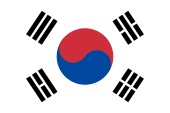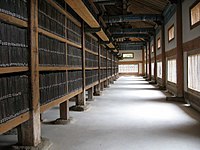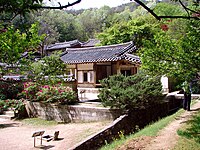World Heritage in South Korea
The world heritage in South Korea (as of 2016) includes 14 UNESCO world heritage sites , including twelve world cultural heritage sites and one world natural heritage site. The East Asian state of South Korea joined the World Heritage Convention in 1988, and the first three World Heritage sites were added to the World Heritage List in 1995. The neo-Confucian Academies Seowon were registered as the last World Heritage Site in South Korea to date .
World heritage sites
The following table lists the UNESCO World Heritage Sites in South Korea in chronological order according to the year of their inclusion on the World Heritage List (K - cultural heritage, N - natural heritage, K / N - mixed, (R) - on the Red List of World Heritage in Danger ).
![]() Map with all coordinates of World Heritage Sites: OSM
Map with all coordinates of World Heritage Sites: OSM
| image | designation | year | Type | Ref. | description |
|---|---|---|---|---|---|
| Seokguram Cave Temple and Bulguksa Temple | 1995 | K | 736 | The Seokguram Grotto ( Lage ) with its Buddha statue and the Bulguksa Temple ( Lage ) with its wooden architecture and stone terraces in Gyeongju , the capital of the Silla Empire, are outstanding examples of Buddhist religious architecture as a material expression of Buddhist belief. | |
|
Haeinsa Temple, Janggyeong Panjeon, repository of the Tripitaka Koreana tablets ( location ) |
1995 | K | 737 | The Janggyeong Panjeon in Haeinsa Temple is the repository of around 80,000 wooden tablets from the Tripitaka Koreana , which were used to print Buddhist scriptures. They form the most complete and accurate collection of Buddhist teaching texts in the world. The storage buildings are specially designed to provide natural ventilation and adjust temperature and humidity to keep the wooden panels from deteriorating. | |
|
Jongmyo Shrine ( location ) |
1995 | K | 738 | Jongmyo Shrine is a Confucian ancestral shrine in Seoul . It serves to commemorate the ancestors of the rulers from the Joseon dynasty . The shrine was built in 1394 under King Taejo , the first king of the dynasty, and has been expanded several times since then. After its destruction in the Imjin War , it was rebuilt in 1601. The traditional rituals of ancestor worship, accompanied by music and dance, are practiced annually as Jongmyo jerye , they are part of the intangible cultural heritage of South Korea. | |
| Changdeokgung Palace | 1997 | K | 816 | The Changdeokgung Palace is one of five remaining royal palaces from the Joseon Dynasty in Seoul . It was built between 1405 and 1412 by King Taejong as the second palace next to Gyeongbokgung, the actual main residence of the Joseon dynasty. The palace is an exceptional example of Far Eastern palace architecture and design, in which public and residential buildings have been integrated into and harmonized with their natural surroundings. | |
|
Hwaseong Fortress ( location ) |
1997 | K | 817 | Hwaseong Fortress in Suwon was built at the end of the 18th century on the orders of King Jeongjo . It consists of 44 individual structures surrounded by a 5.7 km long and up to 7 m high wall. Four buildings with gates enabled access from all four directions. The fortress represents the pinnacle of 18th century military architecture and shows important developments in construction and in the use of materials that reflect the exchange of scientific and technical achievements between East and West. | |
|
Historic Sites of Gyeongju ( Lage ) |
2000 | K | 976 | Outstanding examples of Korean Buddhist art in the form of sculptures, reliefs, pagodas and the remains of temples and palaces in Gyeongju , the capital of the Silla Empire, especially from the 7th and 10th centuries, including u. a .: Mount Namsan with Buddhist temples, stone statues, pagodas and stone lanterns, the Banwolseong Palace, the Donggung Palace with the Wolji Pond, the Cheomseongdae Observatory, the Forest of Gyerim , the groups of tumuli Daereungwon , Noseori , Nodongri and Oreong , Bunhwangsa Temple and the ruins of Hwangnyongsa Temple and the mountain fortress of Myeonghwal . | |
| Gochang, Hwasun and Ganghwa dolmen sites | 2000 | K | 977 | The dolmen sites of Gochang ( Lage ), Hwasun ( Lage ) and Ganghwa ( Lage ) encompass several areas where dolmens from prehistoric times were found in the most varied of variations and in a particularly high density, which are exceptional in Korea and in the world. They bear witness to the global prehistoric technological and social phenomenon that occurred in the 2nd and 3rd millennium BC. Led to the appearance of grave and ritual monuments, which are built from large stones ("megalithic culture"). | |
|
Jeju volcanic island and lava tunnel ( location ) |
2007 | N | 1264 | Three natural objects on the volcanic island of Jejudo , which, in addition to their outstanding aesthetic beauty, also bear witness to the history of the planet and contribute to the understanding of global volcanism: the Hallasan shield volcano in the center of the island, the Geomunoreum lava tube system in the northeast and the one off the east coast in Sea lying tuff cones Seongsan Ilchulbong . | |
| Tombs of the Kings of the Joseon Dynasty | 2009 | K | 1319 | The royal tombs of the Joseon Dynasty are shaped by the principles of Pungsu and provide an outstanding example of a type of ensemble of architecture and landscape that represents a significant stage in the development of burial mounds in connection with Korean and East Asian tombs. 40 tombs of kings and queens from the Joseon period are located in 18 areas, most of them in the outskirts of Seoul . | |
| Historic villages of Hahoe and Yangdong | 2010 | K | 1324 | The historic villages of Hahoe ( Lage ) and Yangdong ( Lage ) were built in the 14th – 15th centuries. Founded in the 18th century and expanded to its present size and composition by the late 18th and 19th centuries. They are considered to be the two most representative representatives of historical clan villages from the early Joseon dynasty . | |
| Namhansanseong Fortress | 2014 | K | 1439 | Namhansanseong Mountain Fortress, designed in the 17th century as an emergency capital for the Joseon Dynasty , is 15 kilometers southeast of Seoul . It is a prime example of a fortified city and contains evidence of various types of military, civil and religious buildings within its fortified walls. | |
| Historic sites of Baekje | 2015 | K | 1477 | Eight cultural sites from the late period of the Baekje Kingdom (475 to 660 AD) in or near former capitals of the kingdom: Ungjin, (today Gongju ), Sabi (today Buyeo-eup ) and Iksan bear witness to the cultural exchange between the ancients Kingdoms in Korea, China and Japan as well as for the spread of Buddhism in East Asia. Specifically, these are the fortress Gongsanseong , the royal tombs of Songsan-ri , the archaeological site of Gwanbuk-ri with the fortress Busosanseong , the temple complex Jeongnimsa , the royal tombs of Neungsan-ri , the city wall of Naseong , the archaeological site of Wanggung-ri and the Mireuksa temple complex . | |
| Sansa, Buddhist mountain monasteries in Korea | 2018 | K | 1562 | Seven traditional temples: Beopjusa , Bongjeongsa , Buseoksa , Daeheungsa , Magoksa , Seonamsa and Tongdosa | |
| Seowon, Korean Neo-Confucian Academies | 2019 | K | 1498 | includes nine Seowon , i.e. H. Confucian Academies. Three more Seowon are already part of the 2010 World Heritage List of Historic Villages of Hahoe and Yangdong . |
Tentative list
The sites that are intended for nomination for inclusion in the World Heritage List are entered in the tentative list . As of 2019, 13 sites are entered in the tentative list of South Korea, the last entry was made in 2019. The following table lists the sites in chronological order according to the year of their inclusion in the tentative list.
![]() Map with all coordinates of current World Heritage candidates: OSM
Map with all coordinates of current World Heritage candidates: OSM
| image | designation | year | Type | Ref. | description |
|---|---|---|---|---|---|
| Kangjingun Distilleries | 1994 | K | 385 | 188 sites | |
| Seoraksan National Park | 1994 | N | 386 | The Seoraksan National Park is a retreat for the long-tailed goral . In the Cheonbuldong Valley is the 19 m high statue of the Buddha of Reunification | |
| Sites of fossilized dinousaurs on the south coast | 2002 | N | 1640 | ||
| Wadden Sea of the southwest coast | 2010 | N | 5482 | ||
| Salt pans | 2010 | K | 5484 | Sinan and Yeonggwang-gun salt flats | |
| Petroglyphs at the Daegokcheon | 2010 | K | 5486 | Bangudae and Cheonjeon petroglyphs on the rock walls of the Daegokcheon River | |
| Ancient mountain fortresses in Central Korea | 2010 | K | 5488 | includes seven mountain fortresses in Central Korea: Samnyeon Sanseong (nominated as early as 1994), Sangdang Sanseong , Mireuk Sanseong , Chungju Sanseong , Jangmi Sanseong , Deokju Sanseong and Ondal Sanseong | |
| Upo wetland | 2010 | N | 5576 | ||
|
City fortress and Naganeupseong site ( location ) |
2011 | K | 5598 | Nagan-myeon ( 낙안면 ), Suncheon-si ( 순천시 ), Jeollanam-do Province ( 전라남도 ) | |
| The village of Oeam | 2011 | K | 5599 | Rural community of Songak-myeon ( 송악면 ), Chungcheongnam-do Province ( 충청남도 ), south of downtown Asan ( 아산시 ) | |
| Seoul City Walls | 2012 | K | 5781 | includes part of the city wall of Seoul with gates, towers and signal mounds
|
|
| Stone Buddhas and pagodas of the Hwasun Unjusa Temple | 2017 | K | 6171 | 22 stone pagodas and 101 stone Buddha statues of the Unjusa temple in Hwasun
|
|
| Gaya tumuli | 2019 | K | 6371 | The proposal includes 7 clusters of burial mounds from the time of the Gaya Confederation : Daeseong-dong tumuli in Gimhae , Marisan tumuli in Haman- gun, Okjeon tumuli in Hapcheon- gun, Jisan-dong tumuli in Goryeong- gun, Songhak- dong tumuli in Goseong- gun, Gyo-dong and Songhyeon-dong tumuli in Changnyeong -gun, Yugok-ri and Durak-ri tumuli in Namwon
The Jisandong barrows and the barrows in Gimhae and Haman have been on the tentative list since 2013. |
See also
Web links
- South Korea on the UNESCO World Heritage Center website.
Individual evidence
- ↑ South Korea. In: whc.unesco.org. UNESCO World Heritage Center, accessed June 7, 2017 .
- ^ Tentative list of South Korea. In: whc.unesco.org. UNESCO World Heritage Center, accessed June 7, 2017 .




























